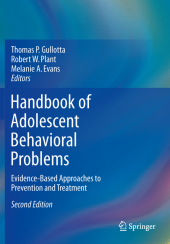 Neuerscheinungen 2015Stand: 2020-02-01 |
Schnellsuche
ISBN/Stichwort/Autor
|
Herderstraße 10
10625 Berlin
Tel.: 030 315 714 16
Fax 030 315 714 14
info@buchspektrum.de |

Melanie Evans, Thomas P. Gullotta, Robert W. Plant
(Beteiligte)
Handbook of Adolescent Behavioral Problems
Evidence-Based Approaches to Prevention and Treatment
Herausgegeben von Gullotta, Thomas P.; Plant, Robert W.; Evans, Melanie
2. Aufl. 2015. xxxiii, 697 S. 7 SW-Abb. 254 mm
Verlag/Jahr: SPRINGER, BERLIN; SPRINGER US; SPRINGER 2015
ISBN: 1-489-97674-4 (1489976744)
Neue ISBN: 978-1-489-97674-1 (9781489976741)
Preis und Lieferzeit: Bitte klicken
The Second Edition of the Handbook of Adolescent Behavioral Problems clarifies the current state of treatment and prevention through comprehensive examinations of mental disorders and dysfunctional behaviors as well as the varied forces affecting their development. New or revised chapters offer a basic framework for approaching mental health concerns in youth and provide the latest information on how conditions (e.g., bipolar disorder, suicidality, and OCD) and behaviors (e.g., sex offenses, gang activities, dating violence, and self-harm) manifest in adolescents. Each chapter offers diagnostic guidance, up-to-date findings on prevalence, biological/genetic aspects, risk and resilience factors, and a practical review of prevention and treatment methods. Best-practice recommendations clearly differentiate among what works, what might work, what doesn´t work, and what needs further research across modalities, including pharmacotherapy.
Key topics addressed include:
Families and adolescent development.
Adolescent mental health and the DSM-5.
Oppositional Defiant Disorder and Conduct Disorder.
Autism spectrum disorder.
Media and technology addiction.
School failure versus school success.
Bullying and cyberbullying.
The Second Edition of the Handbook of Adolescent Behavior Problems is a must-have reference for researchers, clinicians, allied practitioners and professionals, and graduate students in school and clinical child psychology, education, pediatrics, psychiatry, social work, school counseling, and public health.
Section I: Introduction and Overview.- Chapter 1. An Overview of Adolescent Development.- Chapter 2. From Theory to Practice: Treatment and Prevention Possibilities.- Chapter 3. DSM V and Adolescent Behavioral Problems.- Chapter 4. Biological / Genetic Influences on Adolescent Development.- Chapter 5. Family Influences on Adolescent Development.- Chapter 6. Community Influences on Adolescent Development.- Chapter 7. Evidence-Based Practice.- Section II: Disorders.- Chapter 8. Intellectual Disabilities.- Chapter 9. Communication and Learning Challenges.- Chapter 10. School Failure.- Chapter 11. Anxiety Disorders.- Chapter 12. Posttraumatic Stress Disorder.- Chapter 13. Attention-Deficit Hyperactivity Disorder.- Chapter 14. Depression.- Chapter 15. Bipolar Disorder.- Chapter 16. Suicide.- Chapter 17. Oppositional Defiant Disorder and Conduct Disorder.- Chapter 18. Obesity.- Chapter 19. Eating Disorders.- Chapter 20. Autism.- Chapter 21. Schizophrenia.- Section III: Problem Behaviors.- Chapter 22. Media/technology addiction.- Chapter 23. Bullying.- Chapter 24. Delinquency.- Chapter 25. Gangs.- Chapter 26. Homicide.- Chapter 27. Substance Misuse.- Chapter 28. Gambling.- Chapter 29. Adolescent Sex Offenders (Include incest here).- Chapter 30. Dating Violence.- Chapter 31. Adolescent Pregnancy.- Chapter 32. Physical / Emotion Abuse and Neglect.- Chapter 33. Self-Inflicted Harm.- Section IV: Services and Conclusion.- Chapter 34. Young Adult Services.- Chapter 35. Epilogue.
"This book discusses theoretical and treatment approaches to DSM-5 childhood diagnostic categories, along with specific problem areas as well as prevention methods. ... The intended audience is practitioners, policymakers, and human service directors, as well as graduate students in the helping professions. ... This book does a good job of covering a number of DSM-5 diagnostic categories and behavior problems. With the introduction of DSM-5, this update was necessary." (Gary B. Kaniuk, Doody´s Book Reviews, May, 2016)


